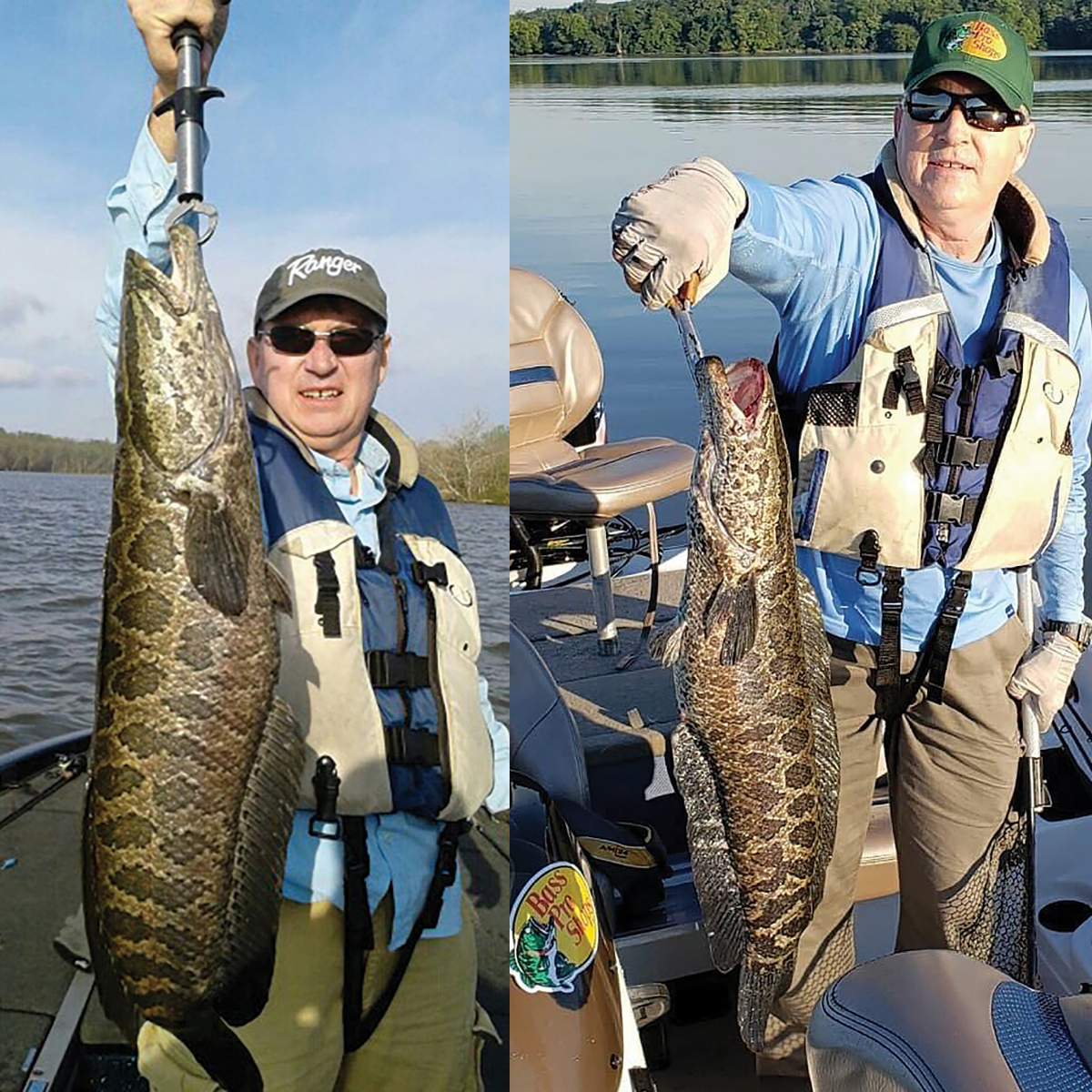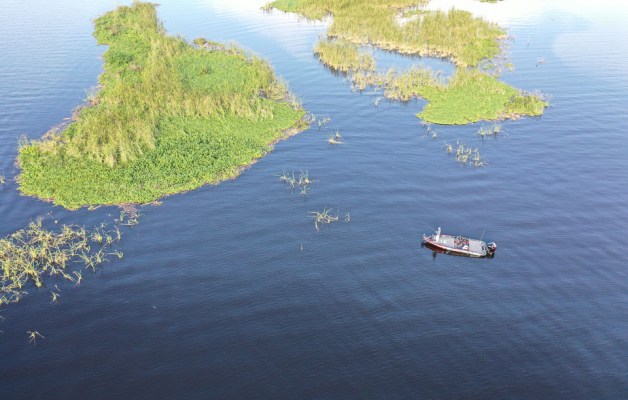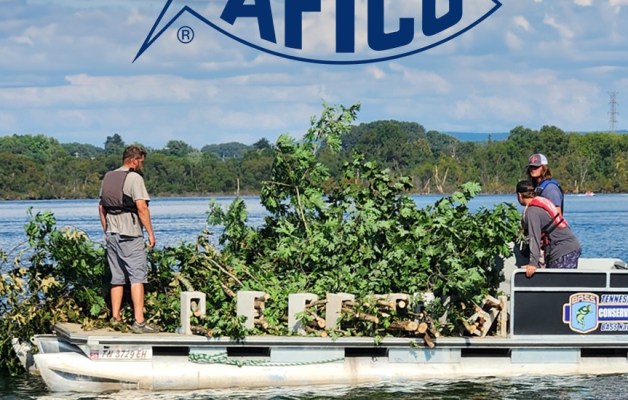
A welcome sportfishing addition for a few, the invasive predators are causing problems for native species in many areas
After being illegally introduced into the Potomac River in 2004 and the Rappahannock in 2012, predatory northern snakeheads don’t appear to be the threat to native sport fisheries in those waters that we feared they would be. Farther up Chesapeake Bay and on the eastern side, however, anglers and watermen view the outlook as far more grim.
“I believe it is safe to say we have seen no impacts to largemouth bass populations [in the Potomac and Rappahannock],” said John Odenkirk, a fisheries biologist with the Virginia Department of Wildlife Resources (VDWR).
“In fact, populations of bass have improved in both rivers during snakehead colonization,” he added. “I don’t think this improvement has been in response to snakehead presence, but rather those habitat conditions that favor one species, favor the other. Tidal rivers are dynamic systems, and habitat features such as SAV (submerged aquatic vegetation) can vary significantly from year to year resulting in highly variable recruitment.”
Additionally, many bass anglers and guides will assert that the aggressive, fast-growing exotic has added enjoyment to a day on the river. Some clients even prefer fishing for snakeheads, said Steve Chaconas, a veteran Potomac guide, who added that their popularity has waned as “media hype” lessened, along with numbers of fish caught.
“They are still being caught but are more wary than before,” he said. “We still see a lot of them, but they are reluctant to take baits. However, kayak anglers are really scoring on them. They are able to fish areas where more [fish] are concentrated and not as accessible to bass boats.”
Guide Michael Hall echoed those sentiments, while emphasizing that snakeheads “are here to stay.”
“I do not believe snakeheads are a threat to the bass population,” he said. “In fact, they are a great forage fish for largemouth bass when they are young. They are opportunistic predators, put up amazing fights and will bite a variety of lures.”
Northeast of Baltimore, however, “the appearance of snakeheads into our brackish and freshwater bass fishing is having a detrimental impact,” said Scott Sewell, conservation director for the Maryland B.A.S.S. Nation, who fears they will become the dominant predatory fish in the Middle River. “In many areas where I have traditionally enjoyed good bass fishing, the catching is down, and I have noticed an increase in snakeheads.”
He added that he’s seeing far fewer baitfish on Hogpen Creek, a tributary of the Middle, where he’s lived for more than 25 years.
“I’ve always had hundreds of minnows living along my property’s vegetated shoreline until about three years ago,” he said. “Now there are none.
“On any given day, I can stand on my property and see numerous snakeheads slowly swimming by, some of them 30 inches and longer. They are having a negative impact, and I fear it will only get worse.”
On Maryland’s Eastern Shore, Caz Kenny, Eddie Bramble and Gary Smith, co-founders of Blackwaters Edge, sadly concur. The three founded their organization to inform and educate anglers about snakeheads and encourage them to catch, keep, and eat them, which biologists say is the best way to minimize their impact. In raising awareness and sponsoring tournaments, they’ve also generated income for local economies.
“People saw what they were doing in the Potomac and moved them here, where they’ve done damage,” Kenny said. “But we’ve put a hurt on ’em and have been able to cut their numbers down in Blackwater River.”
Maryland Department of Natural Resources biologist Joe Love confirmed that changes in fish abundance have occurred in the Blackwater since snakeheads were illegally introduced.
“Caz and Gary are right that snakeheads have established themselves on the Eastern Shore and have likely forever impacted the ecosystems there,” Love said. “Also, there are other impacts that go unmeasured, such as diversity or abundance of frogs, which are also consumed by snakeheads. The anecdotes that they provide help clarify the picture because they are commercial watermen and they provide keen insight into the fisheries in which they work.”
Along with fish and frogs, crawfish and even ducks are among the species whose numbers have been diminished by snakeheads, according to Kenny.
“In 10 years, we’ve watched this fishery collapse and now we catch few bass,” Kenny said. “The snakeheads are going after catfish now because there’s nothing left to eat.”
Additionally, snakeheads on the Eastern Shore benefit from thousands of acres of shallow, marshy habitat in the Blackwater National Wildlife Refuge, where they can feed and breed, unpressured by anglers.
“They migrate up creeks when it rains,” Smith said.
“Now they’re up in the Susquehanna River Flats too. They’re going to devastate so many Maryland fisheries.”
More recently, snakeheads were found above the Conowingo Dam on the Susquehanna River in Pennsylvania. They have been confirmed in Meadow Lake and are thought to be present in the lower Schuylkill and Delaware rivers as well.
Why are snakeheads more damaging to some fisheries and not so much to others? Biologists can’t say definitively, but likely the most important variables are habitat and forage abundance. The Potomac and Rappahannock are larger, deeper fisheries with abundant forage and more accessible water for anglers and bow fishermen to target snakeheads. The Middle, Blackwater and other tributaries are smaller, shallower, less dynamic and tied to shallows and marshes, where snakeheads can more easily establish dominance.
“Based on reports from Virginia, our own observations and those of watermen,” Love said, “it seems that snakeheads could compete with other top predators, like bass, if resources become limited; snakeheads can lower the abundance of prey; and measuring an impact of snakeheads in an ecosystem depends on their abundance and distribution.”
The bottom line is that snakeheads can do damage, and that’s why it’s illegal to move them. An added reason is that they are carriers of Largemouth Bass Virus.
“We continue to find them in new water bodies and new watersheds,” said Virginia Fisheries Chief Mike Bednarski. “To disincentivize the spread, we do not acknowledge snakeheads for a state record or a trophy fish award and have no intent of doing so. We also have no intention of implementing protective measures (size/bag limits) on snakeheads and continue to advocate for anglers to keep any they catch. Containment and population control are our main objectives.”
Snakehead regulations
In Virginia, anglers are required to report snakeheads kept but are not required to kill them if the fish are immediately released. They must be dead if they are in possession.
“However, the department asks that all snakeheads be killed if possible,” VDWR said.
In Maryland and Pennsylvania, anglers also are not required to kill snakeheads. But they may not possess, import or transport live snakeheads.
“Next year, we are working with the U.S. Fish and Wildlife Service to create a reward-tagging program that incentivizes anglers to harvest the fish and report the tag number, which gives us data and helps bolster creation of a harvest fishery,” Maryland’s Joe Love said.





